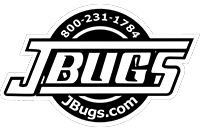JBugs Video Series
VW Dash Switch Testing - Emergency Flasher Switch & Flasher Relay:
Video Overview:
Before we get to installing a new wiring harness in our 1971 Super Beetle we’re bench testing all of the electronic components here at the bench to make sure they work. In this video we test a new Emergency Flasher or Hazard Switch (as our original one was in pieces) and our originally flasher relay. The hazard switch wiring is complicated as it receives and sends power out at multiple terminals as it connects to the fuse box, flasher relay, turn signals and switches. Follow along with our tech as he shows how to test the components at the bench.
Video Transcript:
Hi! Sam here with JBugs.com
We're going to go over testing some of the electrical components and switches for our car, before we install them, along with our new wiring harness.
Hazard Switch
In this video, we're going to test our emergency light hazard switch and our flasher relay.
The hazard switch is fairly complicated as it has wires running to it, at the 30 terminal for battery power,
and at the 15 terminal for ignition power, both coming from the fuse box.
It also sends power out to the flasher relay, from the plus or 49 terminal,
and has power coming back, from the flasher relay, to the 49A terminal.
Then it sends power out to the turn signals, when it's turned on, through the L and R terminals.
Like I said, it's a fairly complicated switch.
There is a ground on the side of the switch, so that the indicator light on the knob will turn on, when the hazard switch is on.
Some switches will actually have a 58B terminal.
That turns on the indicator light inside the knob very dimly, so it lights up when you turn the headlights on, if you were to hook it up.
Continuity Test
We'll test the switch with a continuity tester and use a lead to provide power in to the switch.
We touch a lead to the 30 terminal, which would be battery power in.
At the off position, we don't have power going out to any of the other terminals.
Pulling the knob out, to turn on the switch, and we now have power at the 49 terminal.
That power would go out to our flasher relay, here to the 49 terminal on the flasher relay.
Then the power would go from the 49A terminal on the relay, back to the hazard switch at the 49A terminal on the switch.
With power from our meter at the 49A terminal, we have power at the L and the R terminals, which would send power out to our turn signals.
Turning the switch off and we no longer have power at the L and R [terminals].
The 15 terminal only has power when the ignition switch is on but the hazards will still work regardless of whether or not the ignition switch is on or off.
Load Test
To further show how the switch works, and to put a load test on the flasher relay,
I'm going to use a bunch of jumper wires and hook up the hazard switch and the flasher relay.
Now with some various jumper wires attached, connecting the hazard switch to the relay and ground wires that connect to a jumper box.
We can hook up a power wire from our jumper box to the 30 terminal, pull on the knob and the light lights up dimly and we can head the relay buzzing.
We hook up power to the 15 terminal, pull on the knob, and the same thing happens.
All are good signs but to see if everything is working properly; we grab a test light, ground it out,
and touch either the L or the R terminal, pull on the knob, and our light turns on.
Accidentally shorting out the wire on the switch, at the same time, causes the flasher to operate momentarily and our light blinks.
This illustrates why a test light alone won't typically operate the flasher relay.
Because our relay is a thermally operated one, it needs a larger current draw to make it flash.
We disconnect the test light and then we use a short length of wire and a dual filament light bulb.
We ground out the socket of the bulb, on the hazard switch housing, with a wire.
Then, we touch the bottom contacts of the bulb to the L or the R terminal on the switch.
We pull the knob; the bulb and the light in the knob turn on and start flashing,
telling us that both the switch and the relay work and can be installed in our car.




